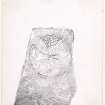Scheduled Maintenance
Please be advised that this website will undergo scheduled maintenance on the following dates: •
Every Thursday from 17th October until 7th November from 11:00 to 15:00 •
Tuesday, 22nd October from 11:00 to 15:00
During these times, some services may be temporarily unavailable. We apologise for any inconvenience this may cause.
Skinnet Chapel
Cross Slab (Early Medieval)
Site Name Skinnet Chapel
Classification Cross Slab (Early Medieval)
Alternative Name(s) Skinnet, St Thomas' Chapel
Canmore ID 318991
Site Number ND16SW 2.01
NGR ND 1309 6205
Datum OSGB36 - NGR
Permalink http://canmore.org.uk/site/318991
- Council Highland
- Parish Halkirk
- Former Region Highland
- Former District Caithness
- Former County Caithness
Skinnet 2 (St Thomas), Caithness, cross-slab
Measurements: H 1.5m, W 0.84m, D 0.13m
Stone type: hard sandstone
Place of discovery: ND 1309 6205
Present location: it stands about 1.8m from the S wall of St Thomas Chapel.
Evidence for discovery: known by 1910 when A O Curle recorded it for RCAHMS.
Present condition: very worn and subject to surface flaking, also covered in lichen.
Description
An earthfast slab of irregular shape, one face has an encircled cross-of-arcs carved in low relief. The upper arm is filled with an interlace knot and traces of similar infilling may be detected in the left-hand arm (the other two are too badly eroded). There is a plain roundel at the intersection of the arms. The suggestion of a shaft may be the effect of relatively recent surface flaking, as it appears not to be present on James Ritchie’s photograph of 1906 (RCAHMS SC 676531).
Date: eighth century.
Compiled by A Ritchie 2016
Skinnet 2 (St Thomas), Caithness, cross-slab
Measurements: H 1.5m, W 0.84m, D 0.13m
Stone type: hard sandstone
Place of discovery: ND 1309 6205
Present location: it stands about 1.8m from the S wall of St Thomas Chapel.
Evidence for discovery: known by 1910 when A O Curle recorded it for RCAHMS.
Present condition: very worn and subject to surface flaking, also covered in lichen.
Description
An earthfast slab of irregular shape, one face has an encircled cross-of-arcs carved in low relief. The upper arm is filled with an interlace knot and traces of similar infilling may be detected in the left-hand arm (the other two are too badly eroded). There is a plain roundel at the intersection of the arms. The suggestion of a shaft may be the effect of relatively recent surface flaking, as it appears not to be present on James Ritchie’s photograph of 1906 (RCAHMS SC 676531).
Date: eighth century.
Compiled by A Ritchie 2016
Skinnet 2, Caithness (St Thomas), cross-slab
Measurements: H 1.5m, W 0.84m, D 0.13m
Stone type: hard sandstone
Place of discovery: ND 1309 6205
Present location: it stands about 1.8m from the S wall of St Thomas Chapel.
Evidence for discovery: known by 1910 when A O Curle recorded it for RCAHMS.
Present condition: very worn and subject to surface flaking, also covered in lichen.
Description
An earthfast slab of irregular shape, one face has an encircled cross-of-arcs carved in low relief. The upper arm is filled with an interlace knot and traces of similar infilling may be detected in the left-hand arm (the other two are too badly eroded). There is a plain roundel at the intersection of the arms. The suggestion of a shaft may be the effect of relatively recent surface flaking, as it appears not to be present on James Ritchie’s photograph of 1906 (RCAHMS SC 676531).
Date range: eighth century.
References: RCAHMS 1911, no 93; Blackie & Macaulay 1998: no 13.
Compiled by A Ritchie 2016
Field Visit (13 August 1910)
Standing some 6' out from the wall of the chapel and towards the W. end of it, is an upright slab measuring 4'11" in height above ground, 2' 9" in breadth, and 5" in thickness. On the W. face are the remains of an equal-limbed Celtic cross, with a central boss 2 1/2" in diameter from which the arms radiate. Only the upper arm remain at all perfect, the rest of the cross being almost effaced owing to the flaking of the surface of the stone. This arm expands upwards, and is 1' in length and 1' 3 1/2" broad at its outer end where it is convex in outline. It is surrounded by a single moulding, and contains a triquetra knot of interlaced ornament. At the point of intersection it is 2" in width.
Visited by RCAHMS, 13th August 1910
External Reference (1980)
In 1861, a sculptured stone was found in St Thomas' Chapel, Skinnet. Thurso Museum now owns the slab, and it is restored to its complete state; Allen and Anderson (1903) states it was in 6 pieces in 1903 of sandstone, 2.3m x 0.66m x 0.18m, it was decorated on all four faces of which the left one is seriously defaced. Interlace panels cover the right edge, while the front bears an ornamented cross, a horse and a pair of serpentine creatures. Circular bosses lie between the arms of the cross. On the reverse another, less ornate cross, a triple oval (cf Keirs and Sandside) and the crescent and V-rod symbols.
Also from St Thomas's Church, Skinnet came an upright slab measuring 1.5m x 0.83m x 0.13m. It stands c.1.8m out from the S wall of the chapel. On one face are the remains of a Celtic cross, only the upper arm of which is perfect. The rest is almost entirely defaced by the flaking surface.
Information from R Jones 1980


















